Aquaponics is the combination of aquaculture (fish farming) and hydroponics (soil-less plant culture). Aquaponics is the ideal answer to a fish farmer’s problem of disposing of nutrient rich water and a hydroponic grower’s need for nutrient rich water. Essentially, aquaponics mimics every natural waterway on earth. It is used to grow food crops in a concentrated, yet sustainable manner.
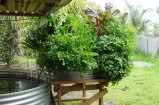
As aquaponic technology continues to develop, there are two primary methods that have evolved. The media-filled bed system, which many backyard enthusiasts use, and the raft system, which most commercial growers use. NFT (nutrient film technique) is a third, less popular method of aquaponics.
In a raft system (also known as float, deep channel and deep flow) the plants are grown in floating Polystyrene boards that float on top of water while a media-filled bed system uses a tank or container that is filled with gravel, perlite or another media for the plant bed.
While algae, submerged plants, and floating plants do a good job of removing fish wastes from a recirculating aquaculture system, so can lettuce, basil, or many other common vegetables and herbs. Fish wastes can be treated with a bio-filter and then allowed to pass through hydroponic troughs, where the roots of cultivated plants can remove the wastes as fertilizer.
In this system, fish are fed in the fish tank. Their wastes are pumped with an airlift pump into a biofilter pipe. This pipe is a smaller version of the biofilter tank used in the recirculating system. As waste-filled water seeps through the biofilter pipe, bacteria and other micro- organisms breakdown and convert the wastes into forms that plants can use as fertilizer.
At the end of the biofilter pipe, the water spills out through an irrigation bar which distributes the fertilizer- filled water into the two hydroponic troughs. As the water slowly flows along the bottom of the hydroponic troughs, plants in pots draw water and nutrients from the passing flow.
Small plants and seedlings are watered through the wicking action of wicking materials in the bottom of their pots. Larger plants grow roots out of the bottom of their pots and into tile flow, soaking tip lots of water and fertilizer.
After passing through the biofilter pipe and the hydroponic troughs, the cleaned water trickles back into the fish tank, where the cycle starts once again.
This article shows you how to build a simple aquaponic system that will produce both fish and vegetables. Like the simple recirculating system, it runs off of one double-outlet air pump. This design takes up a four foot by nine foot space but can be made smaller if space is limited.
SITE
This system needs more light than the simple recirculating system, because vegetable crops tend to need more light than water plants. A greenhouse, bright south-facing window, or protected outdoor location is best.
If, you want to put it inside, you’ll need to use lights to grow your plants.
This system weighs less than the simple recirculating system, but you should get an engineer to look at any floor you think may not be strong enough. There are no through-hull fittings in this system, and as long as the hydroponic tray is higher than the fish tank it can be put just about anywhere. For example, you could put the hydroponic tray on top of an old table with the fish tank on the floor at one end.
PARTS AND TOOLS NEEDED
Hardware
1– 50 gallon plastic barrel – preferably food grade and semi-transparent
1 – 10′ long 1/2″ PVC pipe
1 – 1/2″ PVC male adapter
![]()
2 – 1/2″ PVC tee fittings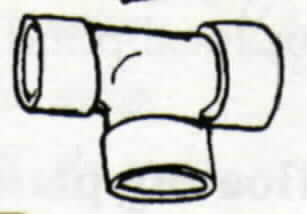
1 – 10′ long 4″ PVC pipe
1 – 4″ end cap![]()
1 – 4″ “L” fitting

1 – aquarium air pump with double outlet
2 – air stones
10′ of air stone tubing
1 – 4′ x 8′ board, 1/4″ or thicker
3 – 1″ x 4″ boards, 8′ long
2 – 1 ” x 2″ boards, 8′ long
50 – 1″ nails
White or carpenter’s glue for bonding the boards together
1 – 6′ by 10′ piece of polyethylene vapor barrier (6mil is best). This is simply a thick plastic sheet used to protect houses from moisture and can be found in most hardware stores.
Staples for staple gun (if using)
5 gallons of oyster shells or dolomite
Plastic pots for plants
Bag of potting soil
Bag of perlite, vermiculite, cocofiber, or peat moss
Tools
Saw – to remove tops of barrels, cut boards and cut pipe
Hammer
Staple gun (optional – see STEP 9)
Felt pen – to mark cuts
Power drill
3/4″ hole saw (or large bore drill bit)
Scissors – to cut plastic
Biological Materials
Buckets of water from local lakes, rivers or ponds
A handful of fresh compost
A handful of good garden soil
A handful of soil from a forest
A handful of soil from a meadow
Some snails from an aquarium store or local pond
Vegetable and herb seeds and seedlings
20 – 30 fish fingerlings (Nile tilapia are recommended)
CONSTRUCTION PROCEDURE
This system takes a day to build if you can get all the materials together and wash and leach the barrels beforehand.
It is a good idea to add the plants a week or so before adding the fish, so that their roots can grow into the water. Add the fish after the system has stabilized for a week or two. Be sure to read ALL the Instructions CAREFULLY before starting to build so that you won’t be surprised by what comes next.
STEP 1. Rinsing the barrel.
Rinse out the barrel with a garden hose. Barrels often contain nasty toxins and should always be handled with care. Wear gloves, long sleeved shirts, long pants, and safety glasses when rinsing.
STEP 2. Leaching the barrel.
The barrel can be leached by filling with water, letting it sit overnight, and then draining the next day. Do this several times, using hot water if available. This will draw out any toxins that are in the plastic itself.
STEP 3. Cutting the lid out of the barrel.
Cut the lid out of the barrel as shown. Leave the rim intact, as it provides support for the barrel, and be sure to leave a small flap to hold the airlift pump. There are several ways of cutting the lid out, depending on what tools you have available. For example, you could drill a small hole and then use a skill saw, or you can drill holes all the way around if you don’t have a saw.

STEP 4. Washing the barrel.
Wash the barrel. Use soap, warm water, and a scrub brush or sponge. Or take the barrel to a commercial car wash. Rinse off the soap, re-fill, and let the barrel leach overnight again.
STEP 5. Making the hydroponic trough.
The hydroponic trough is basically a box lined with plastic. A plan for a four by eight-foot double trough is shown. You can make the trough longer, shorter, narrower, or wider, if you wish. The important thing is that the drains are spaced so that they drain directly into the fish tank, and that there is a space to hold the biofilter pipe.
Cut one of the 1’x4″ boards into a 46 1/2 ” piece and two 16″ pieces. Glue and nail the other two 8′ long 1″ x 4″ boards onto the long sides of the 4′ x 8′ board. Glue and nail the 461/2″ piece onto one end of the 4′ x 8′ board, and glue and nail the 16″ pieces to the other end as shown.
Find the center of the 4′ x 8′ board at-id mark it with a pencil. Mark a line 2 1/4″ from the center line on both sides of the center line. Glue and nail the two 1 x 2″ boards so that their inside edge runs along the 2 1/4″ lines. You should end up with a 4 1/2-” wide trench in between the two 1″ x 2″ boards, where the biofilter pipe will sit.
Using sandpaper, go over the inside of your trough carefully, looking for sharp edges and splinters that might poke through the plastic. Also look to see if any nails have come through that might tear the plastic.
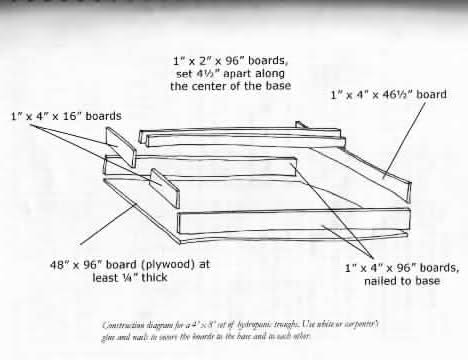
STEP 6. Building the irrigation bar.
Drill a 1/4″ hole through the 4″ endcap, as shown. Be very careful to drill this hole straight or else the joint will leak. Use the caulking gun to cover the threads of a 1/2″ male adapter with silicon sealant. Using a wrench, carefully screw the adapter into the 3/4″ hole. Be sure that it goes in straight. You should be able to screw it until it is flush with the surface of the end cap.
Cut two pieces Of 1/2″ pipe 1 foot long. Cut one piece 1 inch long. Clean the cut edges with sandpaper and then push the pipe together as shown.
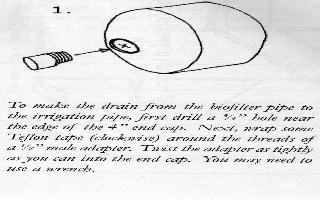
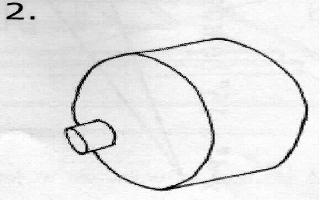
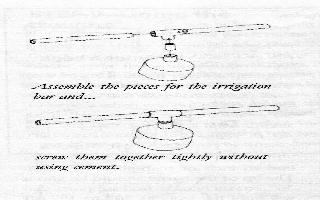
STEP 7. Building the biofilter pipe.
If your trough is eight feet long, then cut your 4″ pipe to be nine feet long (i.e. cut one foot off the end). The pipe should be 1 foot longer than the trough. Being careful not to bump the newly attached irrigation bar, twist the end cap onto one end of the 4″ pipe.
Carefully rinse the oyster shells or dolomite. The smallest pieces should be no smaller than ‘/4″ diameter, to prevent the biofilter from getting too clogged. Scoop the oyster shells or dolomite into the biofilter pipe until it is 90% full. Attach the 4″ “L” fitting and set the biofilter pipe aside.
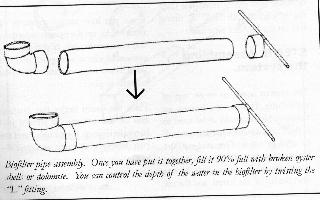
STEP 8. Assembling the system.
The system needs to sit on top of something. Pallets, saw-horses, or concrete blocks could Al be used to support the hydroponic troughs off of the ground. The end of the hydroponic troughs nearest to the barrel should be just slightly higher than the lip of the barrel, and the far end an inch or so higher than that. The lip of the barrel should be about 36″, so you need to find supports that will hold the troughs 36″ to 38″ off the ground.
Once you have set up supports for the troughs, set the trough onto them and secure with nails. If you are using cement blocks as a support, you may need to use rope or cord to hold the troughs ‘in place.
Place the barrel under the draining end of the troughs. It should just barely fit beneath the troughs, and the two drains should hang well over the open top.
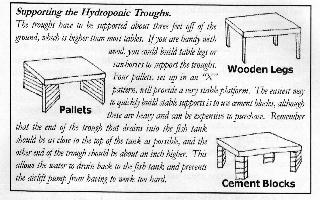
STEP 9. Lining the troughs
Check for sharp or rough edges in the troughs one last time. Lay the plastic over the hydroponic trough and begin fitting it into the troughs. Be sure to allow enough slack in the corners so that the plastic won’t have to stretch when you put plants on top of it. The central trough, where the biofilter pipe will lie, is lined ‘in case of overflows or blockages in the pipe. If the pipe overflows or breaks, the water will simply flow back into the fish tank.
Once the plastic has been fitted, secure it by using a staple gun, home- made pipe-clips’ or binder clips from an office supply store. Although harder to make and use, ‘pipe-clips’ will last longer because they won’t rust.
STEP 10. Placing the biofilter pipe.
Carefully lay the biofilter pipe into the central trough, being careful not to tear the plastic or break the irrigation bar.
Water flows through the biofilter pipe because the entrance to the pipe is higher than the exit. You can adjust the maximum height of water in the biofilter by twisting the “L” fitting at the entrance. Ideally, the biofilter should be mostly full of water, with a thin layer of air at the top.

STEP 11. Setting up the air-lift pump.
Cut a piece of 1/2″ pipe 30″ long. Drill a 3/4″ hole in the middle of the flap that is leftover from the barrel lid and insert the 1/2″ piece through it. You will probably have to widen the hole a little bit with a knife. Push the 1/2″ tee fitting onto the 30″ pipe so that one hole sticks straight up and the other is sideways.
Measure the horizontal distance from the tee fitting to the middle of the 4″ “L” fitting on the end of the biofilter. The idea is to raise the water up the 30″ long pipe, and across to the biofilter. Cut a piece of pipe to span the distance between the 30″ long pipe and the b1ofilter and push it into the tee fitting. Cut another 6″ long piece of 1/2″ pipe and push it into the top of the tee fitting.
Cut two 5′ long pieces of air tubing and hook them up to the outlets of the air pump. Attach an air stone to one of them. Remove the air-lift pipe and drill a ?” hole 4″ from the bottom of the pipe. Insert the air tube without any airstone into the hole. You may have to fold it to get it in. Attach a rock to the to the airstone end of the other air tube and let it rest near the bottom of the tank. This will provide extra oxygen to the fish.
Begin filling the tank with water and turn on the air pump. As the tank becomes full, you will see the amount of water the air-lift pumps increase. When the tank is full, the air-lift should be pumping a reasonable amount of water into the biofilter, the b1ofilter should fill with water, the irrigation bar will drain into the hydroponic troughs, and the troughs should drain back into the fish tank. Check for leaks, add more water if necessary, and let the system run for 24 hours so that it can leach. After 24 hours, drain the system, refill, and let run for another 24 hours before Inoculating.
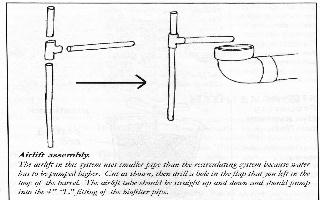
STEP 12. Inoculation.
Inoculate the tanks with biological materials. Sprinkle the handful of compost and soils into the entrance of the b1ofilter. Add the pond/ stream/river water directly to the fish tank, and add a few snails as well. Two or three tablespoons of rotten milk can be added to the b1ofilter tank to encourage a healthy microbial community.
STEP 13. Adding the plants.
Half fill the plant pots with peat, cocofibre, vermiculite, or perlite. This layer will wick water up to the plants until their roots grow out of the bottom of the pots. Fill the remaining half of the pots with compost or good potting soil. Plant seeds or seedlings in the pot and arrange them in the troughs. You should try to place them so that the bottom of the pot touches the water flowing through the trough. Water them well with water from the fish tank once you have put them in the place you want them. Watering them will start the wicking action.
You should make sure that the plants you are growing have enough light and the right temperature. Consult a good hydroponic or gardening book to get this information.

STEP 14. Preparing the system for fish.
You should let the system run without fish for a few days, so the various micro-organisms have time to stabilize and the plants day or two for the water to warm have time to sprout or compensate for transplant shock. This waiting period is also a good idea as it will allow any residual chlorine in the water to escape into the atmosphere. If you are planning on keeping fish that require high temperatures, you will have to install a submersible heater in the system or put the system in a hot place such as a heated greenhouse. Because the system contains a lot of water, it will take a day or two to warm up to the desired temperature.
STEP 15. Adding the fish.
You have to introduce the fish fingerlings slowly to prevent them from being too stressed. If the fish came in a bag, open the top to allow oxygen to enter. Float the bag in the fish tank for an hour or so to allow the water inside the bag to come to the same temperature as the tank. You can hang the open bag from the b1ofilter pipe or the airlift pump so that the fish don’t swim out. Once the temperature is the same, add a little bit of water from the fish tank into the bag. Five minutes later, add a little bit more. Do this a few more times, then slowly tilt the bag underwater so that the fish can swim out of the bag and Into the tank.
Fish that are delivered in other types of containers should be handled the same way.
STEP 16. The first few days.
It is a good idea to cover the tank after first introducing the fish because sometimes fish will try to escape from a new tank. After a few days, the fish will become accustomed to their new tank and a cover will no longer be necessary.
When fish are first moved, they may not be as hungry due to stress. Feed them only a little bit at first, gradually increasing the amount of food as they become accustomed to their new environment.
If all your fish die in the first few days, then something is wrong with your system, with the fish or something happened during transit. Call the person you got your fish from and try to figure out what the problem could be. Usually, you can get replacement fish at a discount if you can convince the fish supplier that there was something wrong at their end.
MAINTENANCE
Regular maintenance helps keep a system healthy by spotting small problems before they become big problems. The regular tasks that you need to perform are listed according to how frequently they need to be done.
Daily Tasks
1. Feed the fish. You can feed fish until they stop eating, or feed them a set amount. Calculating the exact amount of feed to provide is quite complicated, so I suggest feeding them until they stop eating on a daily basis. It is important to watch your fish eat. If they aren’t eating happily then there may be something Wrong.
2. Check that the water level in the fish tank is high enough so that the airlift pump is operating efficiently.
3. Look at the fish to see if they seem healthy.
4. Look at your plants to see if they are happy. Check for insect pests, diseases, and nutrient problems.
Weekly Tasks
1. Harvest plant materials and eat. Feed scraps to the fish or put into a compost pile.
2. Check sediment levels at the bottom of the fish tank. They should not be building up but rather be removed by the airlift pump. If they have built up, use a siphon to remove any excess.
3. Check the air stone to make sure that it isn’t clogged. Clean or replace when necessary.
4. Check ammonia levels. There are numerous kits to measure ammonia available at aquarium stores – read the directions carefully. If ammonia levels are too high, cut back on feed and/ or increase aeration (i.e. add another air stone to the fish tank.)
Monthly Tasks
1. Harvest and restock fish, if required.
2. Remove 5 or 10 gallons of water from the system and replace with water that has sat overnight to let chlorine escape. Use the removed water in a garden.
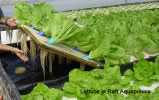 3. Check to see if the biofilter pipe is becoming clogged. If It is, remove the el fitting, dump out the oyster shells or dolomite, rinse, and then replace.
3. Check to see if the biofilter pipe is becoming clogged. If It is, remove the el fitting, dump out the oyster shells or dolomite, rinse, and then replace.
CONCLUSION
You are now an aquaponic farmer, growing happy, healthy fish and vegetables in a recirculating aquaponic system. Congratulations!
* A video of a simple airlift pump in action – Low energy requirement
* Design and Description of an airlift pump – A simple pump with no moving parts
Source: The Urban Aquaculture Manual by Jonathan Woods, Sponsored by Heifer Project International with assistance from the Evangelical Lutheran Church of America, aquaponics.com
Photo: backyardaquaponics.com, aquaponics.com



Please refer anyone from Davao City doing AP? Thank you.
hi Grace,
Did you start your aquaponic setup? I’m also from Davao City
Anyone can help me set up a backyard aquaponic system. I prefer the vertical one because of limited space.
Just near Metro Manila.
Anyone can help me set up a backyard aquaponic system. I prefer the vertical one because of limited space.
Hi to all. I am looking for a potential partner in building an aquaponics farm. If any one is interested PM me at Facebook Mederic Dumapi.
Can you please recommend or refer to me anyone in Davao City who is doing aquaponics/hydroponics?
Hi Alain,
My name is Gerry Antonio. I’m putting up an AP School in Bago Gallera. RaGeTiMi Farms. I have one 10 cu m. AP set-up currently growing ampalaya. Building a bigger 1000 cu.m. system. If interested pls pm me at 0922 8797589.
I want to talk to someone regarding aquaponics. I am very interested in putting one in our backyard. I am not a technical person and putting one by myself is quite a task. Are there people in your team that could set up in our backyard.? I live in Las Pinas. Lastly, I want to see an aquaponics, where can I see one so I will have an idea how it works. Thanks
For Filippino Aquaponics technicians
Immediately start working in Saudi Arabia :
Required :
An agricultural engineer with
aquaponics, hydroponics and biogas experience and high level of technical and mechanical knowledge on commercial systems.
Applicant must be Filipino and speaks english.
job details in the link
http://www.eico-arabia.com/#!careers/c20rb
We value the support of all aquaponics communities in the Philippines to find this technician. And we would like to present a referral reward of $100 and a thank you note provided sourcing the right man for the job.
Email us the CVs at info@eico-arabia.com
Thank you and God bless
Any good Aquaponics supplier you can recommend me to? Thanks!
Many thanks for the detailed step by step instructions. I’m actually quite a technical guy but unfortunately I’m having trouble imagining what the end result should look like. I want to follow your procedure to the letter, but without some pictures of the overall system (preferably labelled as to what is what), it’s hard to envisage what I’m actually attempting to achieve.
Perhaps, if there is someone else in Metro Manila or close by (I’m in Antipolo, Rizal) who has done this, maybe I could visit to view?
I’ve read the instructions but honestly, I can’t even identify what the fish live in? Is it an upright barrel?
Very confused but hoping that I can gain some answers from elsewhere and return to this with a better view on what I need to do.
Thanks again for your effort.
Thank you for the information. I have read quite a number of references on aquaponics before, i appreciate the system and I might as well start a backyard project. However, may I ask for a simple yet realistic financial study or presentation so I may understand that the viability of aquaponics. That’s its not all just spending. Hope you have a reference on this. thank you.
Very helpful info, I want to start this set-up in my backyard. Anyone in Metro Manila with this set-up that I can visit? Need to see something personally before I can do it myself. I'm not a very technical person. Thanks so muchi.
freaking pipe nightmare !! even my cement tab need some fixing !!!
I also made my hybrid Aquaponics design here in Cebu City, Philippines. It’s working great so far..
hi, how was your aquaponics now. Is it still working?
Here You have given fundamental information about hydroponics building and many more. Really very useful blog for all new users.
Hydroponic Gardening Benefits